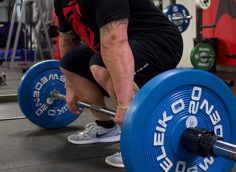Iso-Holds for Gains
An iso-hold is just a pause, and you can pause for a long time or a short time, so don't let the terminology confuse you. This technique works amazingly well for increasing the stimulus of a set.
Let's focus on pausing in the shortened (contracted) position of a movement. With this method, we're focusing on holding this position for a specific period of time that has an ascending resistance curve. Usually I recommend holding for 1-3 seconds per rep.
This would apply to movements like shrugs, spider curls, pec-deck flyes, lateral raises, leg extensions, seated and standing leg curls... you get the picture. Anything that has an ascending resistance curve in conjunction with an exercise that's training the muscle in the shortened position.
Iso-holds in the lengthened position would be what you'd do when you're at the bottom of a goblet squat, leg press, etc., and they'll also increase force production and muscle growth than when compared with equal volumes of shorter muscle length training (1).
"So didn't you just say to use the shortened positions to increase stimulus? Which one is it?"
It's both. You can use either of these methods depending on the exercise you're doing, and what it is that you're trying to get out of the workout.
For example, someone who has shitty biceps will probably benefit more from training the biceps more often and using a lot of movements where the biceps are trained in the shortened position with contracted iso-holds. In that regard, using the isometric hold in said shortened positions is a great way to increase neural pathways so that a better mind-muscle connection is created.
After weeks or even months of using this type of stimulus to create better contractions with the biceps, a lifter could throw in an incline dumbbell curl or a face-away cable curl to train the biceps in the lengthened position. He or she could then throw in some iso-holds at various points in the lowering position to create more stimulus for biceps growth.
Another example of this could be someone who has spent months getting really strong on the leg press with glute emphasis, and then adds a pause at the bottom to each rep (a lengthened iso-hold). This would create more force production and stimulus without them having to do more sets or reps. Good stuff.
One of my favorite ways is to use both types of iso-holds for glutes. You'd do glute bridges then finish with a 15-second hold at the top, then immediately go into goblet squats and start with a 15-second hold at the bottom (lengthened position), then do the reps.
It only takes one round of these for complete glute annihilation if you do it right.
Reference
- Dustin J. Oranchuk, (2018), Isometric training and long-term adaptations: Effects of muscle length, intensity, and intent: A systematic review, doi.org/10.1111/sms.13375





